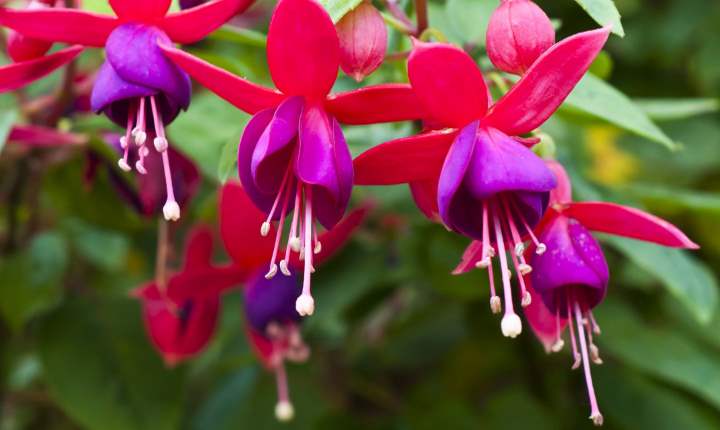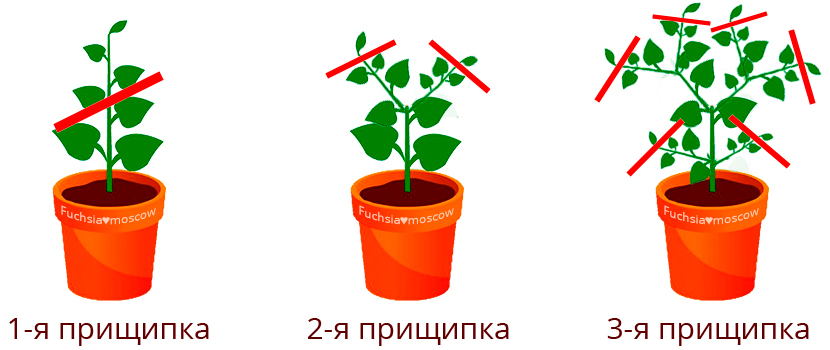Content:
Fuchsia ("ballerina") is quite popular among summer residents and gardeners. However, many are mistaken, considering it an exclusively indoor plant. In natural conditions, shrubs can reach heights of more than 1m, and they require proper care.
How to form a plant correctly
The plant is distinguished by flowers of an interesting shape, combining several shades. Several thinner stems are formed on each branch, on each of which 3-10 inflorescences subsequently develop. The flowers have an outer row of strongly opening pointed petals, several rows of rounded small petals and long stamens at the core. Each of these parts may differ from others in color, be blue, yellow, white, pink, red or purple.
Pruning is necessary to remove the weakest shoots that will bloom poorly. For example, you can immediately remove too long and thin stems or those with only a couple of small leaves, while the rest are distinguished by an abundance of greenery. You also need to cut off the stems that have become stiff over time. You cannot only cut the trunk of the bush.
Fuchsia has faded: what to do next
What to do with fuchsia after flowering? You need to partially cut the stems, this will have a beneficial effect on subsequent flowering. It is best to prune twice: in early fall and mid-spring. First of all, wilted or dried stems are removed. After that, you should cut off young shoots and twigs at the ends. Further, the fuchsia is trimmed based on decorative preferences, that is, the desired crown shape is set.
When pruning fuchsia in autumn, it is important to inspect the branches for harmful insects or diseases affecting the bark. If something similar is actually found, the diseased branch and a small healthy part of it will have to be removed.
How to form fuchsia on a trunk: pruning scheme, recommendations
What to do next when fuchsia has faded? After the fuchsia has faded, the faded cuttings and twigs that have formed above the young buds are removed.
The stem is formed from a healthy cutting with a strong, straight stem. When planting, a stick must be installed to support the main trunk. Next, you need to figure out how to form a planted fuchsia. To start forming fuchsia on a trunk, first it needs to be allowed to grow to the desired height, cutting off all side shoots. When the stem reaches the desired height, the top is cut off, immediately after that young side shoots begin to form. By pinching them, you can get a lush blooming bush.
The formation of the crown of fuchsia is easy to carry out, this can give it a certain shape. For example, you can give it the shape of a heart, a ball, or a small tree, based on the expectation that two more will grow from each cut piece.They will be directed towards the corner at which the trim was made.
Pinching and shaping a fuchsia stalk
Do not pinch the plant too often, at least be careful with this before flowering. Pinching consists in cutting off young shoots and leaves. The tips of very thin twigs, which have recently formed, are cut off, so the strength of the tree does not go to the growth of greenery that is useless in this season, but to ensure that the flowers are large and bloom well. Thanks to the pinching, the growth of the crown slows down; throughout the summer, it should be carried out about once every two weeks. Already in the fall, you can make a full pruning of the crown, while not reducing the number of flowers on the bush. Fuchsia, pruning and pinching of which is carried out correctly, will bloom much more abundantly, more magnificently and a little longer in time.
A properly cut bush is overgrown with many young shoots, at the end of each of which inflorescences are formed. Basically, it is on young shoots that buds are formed, that is, in order to get a profusely flowering bush, you need to cut the maximum number of stems from which new ones will appear
Wintering fuchsia in the open field. Pruning rules for the winter
In most cases, gardeners are advised to dig up fuchsia for the winter and leave it in pots indoors or at home, since this is not so difficult to do. So it will be possible to protect the tree from frost, keeping it warm. If the bushes have already reached rather large sizes or there are a lot of them on the site, they cannot be stored indoors. In this case, you can simply cover the plants with spruce branches, spunbond. They should winter well. Some varieties need to be cut almost below ground level, abundantly cover from above, sometimes even sprinkle 10-15 cm with earth. At the end of spring, the plants are dug up, after which they begin to grow again.
Useful tips for gardeners on pruning and shaping a fuchsia bush
Many are interested in how to cut fuchsia at home and whether it should be done at all. Pruning fuchsia at home should be done less frequently than when grown outdoors. A significant difference will be the size of the bush and the thickness of the stems. If in natural garden conditions a bush-shaped tree with a height of 1.5 m can turn out, then at home a small bush will grow no more than 20-30 cm.
Growing fuchsia at home is a little easier due to the absence of the need to transplant for the winter, and the temperature regime will not change so much throughout the year. And in summer, the scorching sun will not fall on the flower, whose rays often burn through the delicate leaves of fuchsia growing in its natural environment.
Plants that have miniature shapes and small size of leaves, and the flowers themselves, require much less strength and can bloom much earlier than other varieties. They require less care and will bloom even in not the hottest climates.
















